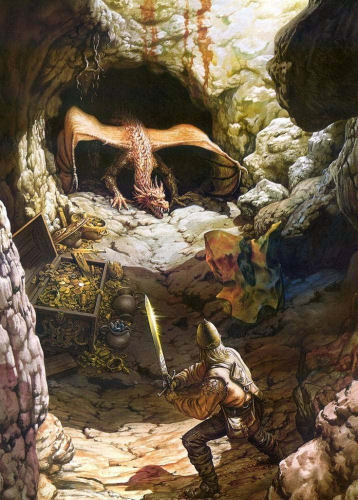‘Tol acharn!’: Part Two of “The Wanderings of Hurin”
Wednesday, June 3, 2009
posted by Deuce Richardson
“He that sees through the eyes of Morgoth, willing or unwilling, sees all things crooked.”
From “The Wanderings of Húrin” by J.R.R. Tolkien
In my first post concerning Húrin, the mightiest mortal warrior of Middle-earth’s First Age, I looked at what befell him before he was released from his imprisonment in Angband. All of that was a prelude to the collection of writings that Tolkien entitled, “The Wanderings of Húrin,” which can be found in The War of the Jewels: The Later Silmarillion.
The tale begins in Angband, the ancient stronghold of Morgoth, wherein Húrin had been held captive for twenty-eight years, all the while being forced to witness Morgoth’s curse upon his family unfold, and always, always, viewing the events through the Dark Lord’s darkling mirror of spite and deceit. A year after the death of Túrin, son of Húrin, Morgoth deemed the time was ripe to unleash the embittered Húrin upon the world…
He feigned that in this he was moved by pity for an enemy utterly defeated, marveling at his endurance. ‘Such steadfastness,’ he said, ‘should have been shown in a better cause, and would have been otherwise rewarded. But I have no longer any use for you, Húrin, in the waning of your little life.’ And he lied, for his purpose was that Húrin should still further his malice against Elves and Men, ere he died.



 We live in halcyon days, my friends. Sure, there’s a global “economic downturn” grinding all and sundry ‘neath its leaden wheels and there is a possible influenza pandemic looming (or “lowering,” as REH might say), but we aficionados of the works of Robert E. Howard and John Ronald Reuel Tolkien have much to celebrate in the many coming months, gloom n’ doom notwithstanding.
We live in halcyon days, my friends. Sure, there’s a global “economic downturn” grinding all and sundry ‘neath its leaden wheels and there is a possible influenza pandemic looming (or “lowering,” as REH might say), but we aficionados of the works of Robert E. Howard and John Ronald Reuel Tolkien have much to celebrate in the many coming months, gloom n’ doom notwithstanding.








